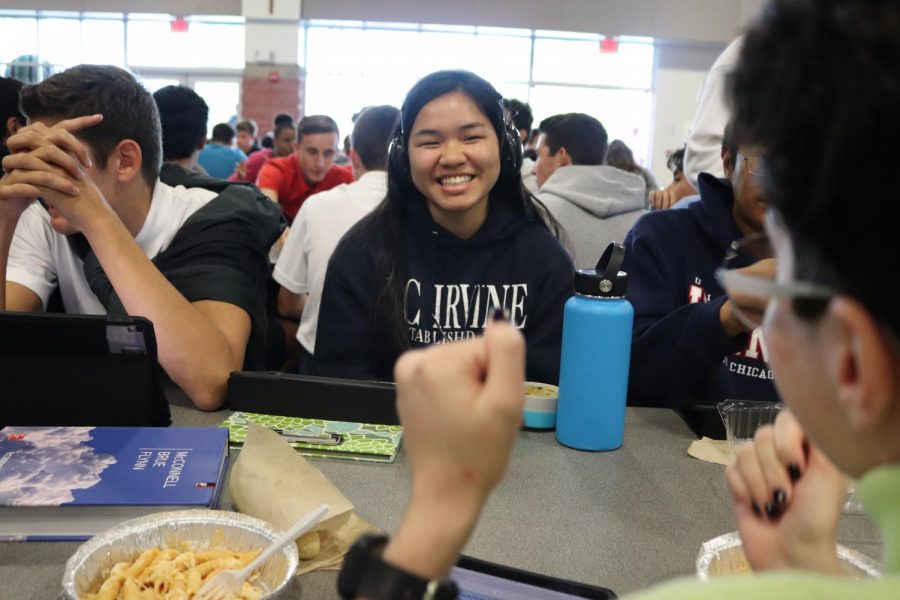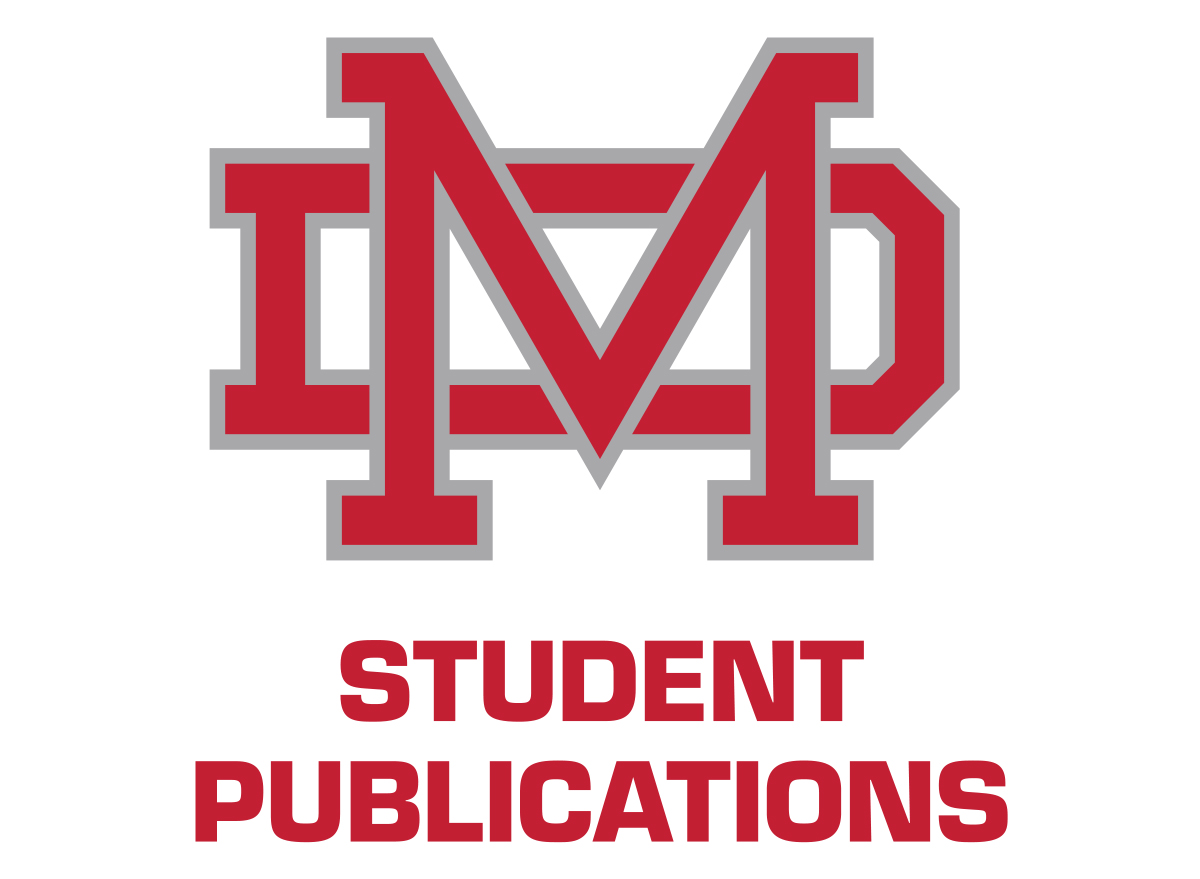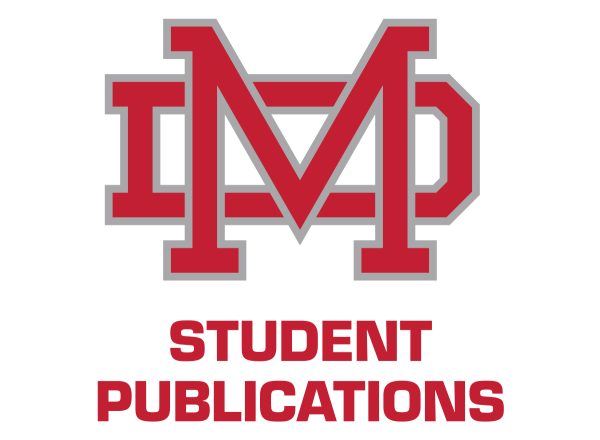Deaf for a Day provides insight into challenges, experiences of deaf and hard-of-hearing people
SILLY SMILES: Senior Maithu Tran laughs as a friend sitting across from her – senior Claire LaFont – demonstrates a silly dance while at lunch in the LeVecke Center. Tran was one of the 11 ASL IV students to participate in the Deaf for a Day experience on Oct. 3.
October 25, 2018
Wearing black sound-eliminating headphones, 11 seniors went through the school day experiencing what it might be like to be a deaf or hard-of-hearing individual.
This experience was part of Deaf for a Day, which took place for the first time in school history on Oct. 3. The seniors are students in Jennifer Battaglia’s block 7 American Sign Language (ASL) IV class.
Used by deaf and hard-of-hearing individuals, ASL is a language that uses hand motions and facial expressions. As one of the foreign languages offered at the school, students are taught how to use correct gestures while learning about the culture and history of the deaf community.
“I want the ASL 4 students to experience this to better stand up for their friends when they see that they are being discriminated against, to stop it and to educate,” said Battaglia, who has been signing since she was 6 years old and received her bachelor’s degree in deaf studies. “I also think that this is a good learning experience for their classmates and the teachers too to realize their behavior and hopefully change their behavior.”
During Deaf for a Day, all teachers on campus were advised to continue their lessons as planned so the students’ experiences would be as authentic as possible. Before the event, AP Government teacher Josh Dutra spoke to Battaglia about her expectations for the students and teachers.
That day in class, Dutra assigned an activity where students had to produce an informative video about different California propositions that would be on the ballot for midterms this November. Out of his four AP Government classes that day, Dutra had at least one ASL participant in three of them. Dutra provided typed out instructions about the assignment and projected them at the front of the room. Even with his additional assistance, Dutra noticed that the participants still seemed confused and had a difficult time planning their projects. In observing the participants, Dutra was reminded of accommodating students with differences in his teaching.
“All of our students have something different than anyone else and I think that it is important that we as teachers always remember that and try to create an environment where everyone with all of their unique life experiences and challenges are accepted and able to learn,” Dutra said. “My biggest takeaway was a reminder to me to make sure that I am creating a learning environment that is open to all students with all different learning types and abilities.”
Some of the participating ASL students expressed their concerns about potentially missing content and understanding instructions for activities in class.
“I really hope that this is a positive impact on Mater Dei so that we do understand that we as hearing people, take our hearing for granted and that deaf people already struggle so much trying to function in a world made for hearing people,” Battaglia said. “Our behaviors and what we do, especially in the classroom, just makes the struggle even harder.”
Despite their concerns, students were eager to use this event as an opportunity to spread awareness about deaf and hard of hearing people.
“We do have a couple of deaf students on campus and I have heard so many stories of them being yelled at from across the room, or teachers turned around facing the wall lecturing where they can’t hear them, or classes being super noisy and they can’t hear the teacher talking,” Battaglia said.
For example, senior Katie Flathom was diagnosed as deaf when she was 4 years old and was given hearing aids. Now in her fourth year as an ASL student, Flathom participated in the event by removing her hearing aids. By participating in Deaf for a Day, she hopes to spread more awareness about the struggles of deaf and hard-of-hearing students.
“I hope [my classmates] take that … when classrooms are loud, it’s really stressful for me because I cannot hear what’s going on and it’s a lot of things going on and even with my hearing aids, I can’t process it … and it’s stressful and very tiring and exhausting to concentrate on what’s going on in the classroom,” Flathom said.
Other ASL students who participated found that the experience was educational and helped them begin to understand the everyday struggles for those who are deaf and hard-of-hearing.
“I know that we have deaf students on campus … and I also have deaf people I talk to and I communicate with regularly, but I’m hoping to gain a new understanding of them and really sort out how I’m going accommodate for a deaf person,” senior Angie Phu said. “I would like to treat them just as I treat you … [and] I want to be as understanding and as accommodating for them as I possibly can through this experience and being in their shoes.”
Though they experienced many difficulties throughout the day, students learned that understanding the challenges of these individuals is very important to contributing to a positive change in society’s view of the deaf and hard-of-hearing community.
“I don’t think I can ever really know what they experience,” senior Juliet Vo said. “Sure, this is me putting in headphones and people seeing the headphones, but, for them, it’s like a constant experience they go through and this is their reality. They don’t get support from teachers … I think it’s a good representation and I think it got the point across. It was a good project.”





![Mater Dei Track runner and freshman Aidan Lynch wins the 400 meter race. The Trinity Lower Level track meet was held Friday, Apr. 21 at Santa Margarita High School. This was the last track meet of the season for the Junior Varsity and Frosh-Soph teams. Freshman Bella Alafita reflects on her season. “I enjoyed seeing the progress I have made from the beginning of this season to the end of this season and felt really great [about] getting a personal best at the end,” Alafita said. “I’m also excited to see how much I can improve next season.” 📸 and post by Boston Crenshaw, staff reporter for the Scarlet Scroll newspaper. #trackandfield #materdei](https://thescarletscroll.com/wp-content/plugins/instagram-feed/img/placeholder.png)


